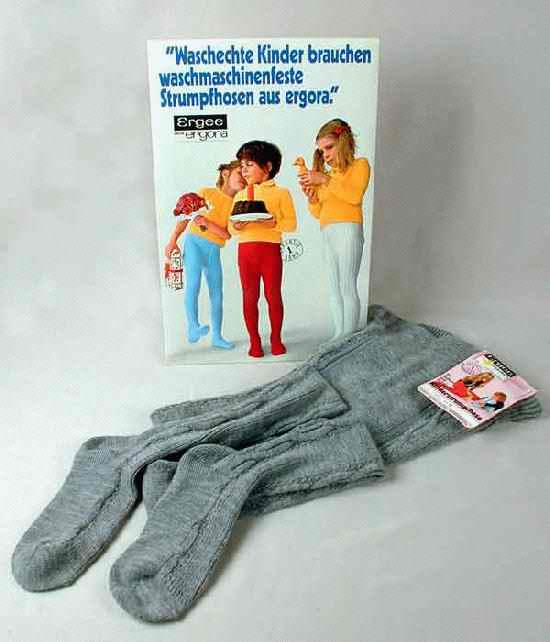
Tights: Weaves

Figure 1.--This German company, Ergora, offers children's tights with a cable knit weave in many different colors. The caption on the box reads, "Waschechte Kinder brauchen waschmaschinenfste Strumphosen aus ergora." I'm not sure what this means, something like, "Genuine washable children need machine washable tights from Ergora."
|
Tights generally are made in a flat weave. Virtually all the tights sold in America are this flat weave. There appears to be much more variety in the tights worn in Germany and other European countries. We have noted European tights had a variety of weaves, mostly commonly bar and ribbed weaves. We have also noted cable weaves. The weight of the weaves varied greatly. Some tights were very tight and form fitting. These sheer tights were generally for formal wear rather than for warmth. Others tights were woven in much heavier weights--in some cases bulky garments. Only limited information, however, is currently available to HBC on weaves. The principal purpose of tights is to keep warm in cold weather. Tights, especially, for boys tend to be highly seasonal garments. HBC at this time does not know how these weaves have varied over time or between countries. We also do not fully understand to what degree the weave is affected by the gender and age of the child.
Chronology
HBC at this time does not have good information on how tights weaves have changed over time.
Styles
The great bulk of tights are generally made in a flat weave. This is especially true in America. HBC has noted, however, more variety in the tights worn in Europe. Some tights had a variety of weaves, mostly commonly bar and ribbed weaves. Kneesocks were made in cable knit weave and some tights were also made in this style. Interestingly we have rarely noted European boys wearing cable knit kneesocks, but we have noted canle knit tights. There were also some formal, usually white tughts, with desisigns woven in. These were often realively sheer tights for wear by little girls on formal occassions. They have also been worn as dress wear, but this is less common.
Weight
The weight of the weaves varied greatly. Some tights were very tight and form fitting. These sheer tights were generally for formal wear rather than for warmth. Others tights were woven in much heavier weights--in some cases bulky garments. These tights were worn for warmth in cold winter wearher.
Purposes
HBC has noted two primary purposes for tights. The principal purpose of tights is to keep warm in cold weather. Tights, especially, for boys tend to be highly seasonal garments. They are much more common in the winter than the summer. They have also been worn as dress wear, but this is less common. Tights were worn for formal occasions. While boys did once wear them for formal occasions, this has by the 1990s become much less common--except in Japan where they are still worn by younger boys for formal occasions--especially school events when the school has a short pants school uniform. The tights worn for formal or dressier occassions tend to be the more sheer type and not the bulky cold-weather tights.
Age
HBC at this time does not have adequate information on the weaves worn by different age groups.
Gender
HBC has little information as to what extent different weaves were worn by different genders. We do know that girls in general were more likely to wear the more sheer tights. Thuis is primarily because girls, especially in America, commonly dressed up in tights for fiormal occassions. This was much less common for boys. Most of the boys weraing tights wore thenm as practical coldweather garment.
Christopher Wagner

Navigate the Historic Boys' Clothing style pages:
[Return to the Main tights weave and pattern page]
[Main hoisery page]
[Stockings]
[Kneesocks]
[Tights]
Navigate the Historic Boys' Clothing Web Site:
[Introduction]
[Activities]
[Bibliographies]
[Biographies]
[Chronologies]
[Countries]
[Style index]
[Contributions]
[Frequently Asked Questions]
[Glossaries]
[Links]
[Boys' Clothing Home]
Created: November 8, 2001
Last updated: November 8, 2001



